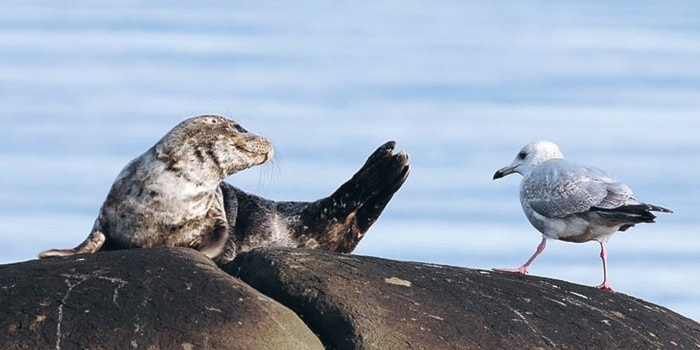Acrobats of the skies, sea gulls can float on the wind currents without a wing beat; they are very agile and can manoeuvre themselves or hover with the ability to land like a feather.
Although we all tend to refer to all gulls as “seagulls” there are over 20 species that live in North America, 19 of these live in B.C. Gulls are a bird species that can often be very difficult to identify especially the juveniles as they have different plumage coloration each year until they reach maturity at four years old.
Overall, gulls are robust, long-winged birds with stout, sharp, hooked bills and webbed feet with the exception of the hind toe. The best method of identification for adult gulls is by the bill, leg and feet coloration, which can black, yellow, red or pink. The western gull is one of the more common gulls in our area and has a very specific habitat range along the coastline of British Columbia south to the Baja in California and Mexico.
This gull is one of the larger species on average 60 centimetres long, the adult birds have white heads and breast with dark grey wings tipped with white dots along the edges. The adults have pink legs, and a yellow bill with a red dot at under the tip which is used to attract the chicks stimulating them to feed; many other species have similar dots or rings varying in color.
On average, western gulls live 15 years but some make it to 25 years. Western gulls are almost exclusively marine birds and are rarely found away from the coastline, they are social birds and usually found in large flocks. They nest offshore on small islands or rocks along the coast; many can be seen off the west coast of Vancouver Island.
Unlike some of their relatives, western gulls feed on the surface of the water or along exposed areas of beach during low tide. They do not dive for food. Gulls by nature are opportunistic feeders dining on a wide variety of food.
At sea, the western gulls will feed on squid, krill and jellyfish which come to the surface. At low tide they will opt for shell fish and snails together with rotting meat from seal or fish carcasses.
Around populated areas they will happily scavenge on human food waste and like so many bird species will flock to the garbage dump to dine on leftovers. They are also well known to beg at picnics along the beach.
Western Gulls are predatory by nature and will prey on other gulls or birds’ nests taking the eggs or young chicks.
This winter Mountainaire Avian Rescue Society (MARS) has rescued several seagulls including two western gulls. During stormy weather these gulls will often seek respite from the storm in nearby urban areas, Superstore in Courtenay being a favourite spot.
Unfortunately, they often are hit by cars which caused one of the rescued gulls to fracture a wing the other sustained neurological damage. The gull with the broken wing is on the mend and should make a full recovery, but the head injury sustained by the other gull caused the bird to fall over and it was unable to stand or walk. Gradually with daily physiotherapy and swimming in a tub this gull is improving.
Gulls in captivity can be a handful. They are very snappy and often bite the hand that feeds them. On the plus side, they are very easy to feed as they will eat a wide variety of food. It is hoped that both these gulls will be released in the New Year along with our two remaining eagles.
This year past has been another busy year with almost 450 cases and I would like to thank all the dedicated volunteers who support MARS, especially the animal caregivers who come each week to tend for the injured wildlife which often is a messy job but so rewarding. Also thanks to the board members who guide us and fundraise and to the people who have made donations.
